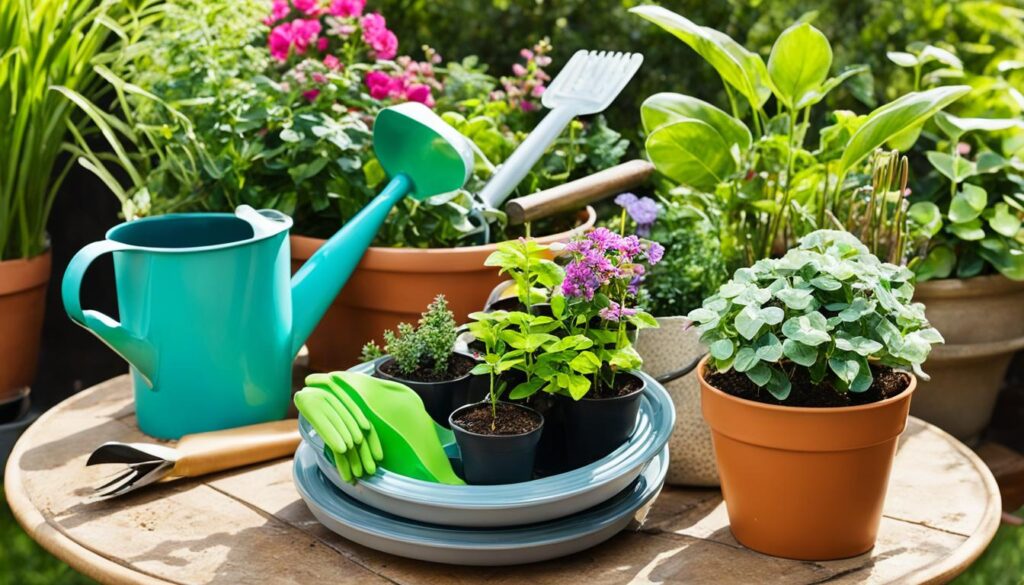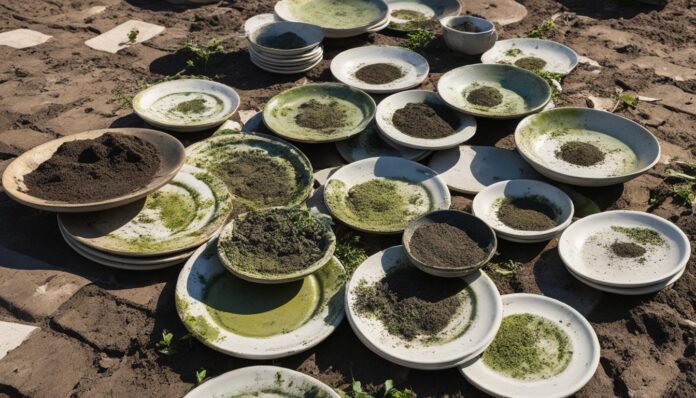Cleaning plant saucers is an essential maintenance task for houseplant owners. Over time, saucers can become dirty and stained, affecting the overall cleanliness and hygiene of the plant. In order to effectively clean plant saucers, there are certain techniques and tips that can be followed.
Key Takeaways:
- Regularly cleaning plant saucers is important for maintaining the health and well-being of houseplants.
- Dirty saucers can attract pests and harbor bacteria and mold, compromising the cleanliness of the plants.
- Effective cleaning techniques include using a combination of boiling water, baking soda, salt, white vinegar, and tinfoil.
- It is important to rinse saucers thoroughly, dry them completely, and clean them regularly to prevent the accumulation of dirt and grime.
- The material of the saucer and proper drainage play a role in the cleanliness and effectiveness of water management.
Importance of Clean Plant Saucers for Proper Plant Care
Clean plant saucers play a crucial role in maintaining the health and well-being of houseplants. By collecting excess water, saucers prevent it from pooling around the base of the plant. This helps to prevent water-related issues such as root rot, which can be detrimental to the plant’s overall health.
Dirty saucers, on the other hand, can attract pests and harbor bacteria and mold. These unwanted guests can compromise the cleanliness of the plant and lead to further complications. Regular cleaning of saucers is essential in promoting proper plant care and ensuring a clean and hygienic environment for the plants to thrive.
To visually illustrate the importance of clean plant saucers, take a look at the table below:
| Type of Saucer | Cleanliness Level | Impact on Plant Care |
|---|---|---|
| Dirty Saucer | Stained and grimy | Negatively impacts plant health |
| Clean Saucer | Spotless and hygienic | Promotes proper plant care |
As you can see from the table, clean saucers contribute to the overall well-being of the plants, while dirty saucers can have a negative impact on plant care.
Effective Techniques for Cleaning Plant Saucers

When it comes to cleaning plant saucers, there are various effective techniques that can be employed to ensure their cleanliness and maintenance. These methods can help remove tarnish, stains, and residue, leaving the saucers looking refreshed and revitalized.
One popular technique involves creating a powerful cleaning solution using simple household ingredients. Start by filling a basin or sink with boiling water. Add a tablespoon of baking soda, a teaspoon of salt, half a cup of white vinegar, and a sheet of crumpled tinfoil to the water. The tinfoil helps create a chemical reaction that aids in removing tarnish from the saucers. Place the saucers in the solution and let them soak for about 10-15 minutes. After the soaking period, gently scrub the saucers using a soft brush or cloth to remove any remaining dirt or stains. Rinse thoroughly with clean water and dry them before placing them back under the plants. This technique works effectively on saucers made of various materials, including plastic, metal, and even ceramic.
Pro tip: For silver saucers, another technique involves using ketchup as a cleaning agent. Apply a small amount of ketchup to a soft cloth and rub it onto the tarnished areas of the saucers. Let the ketchup sit for a few minutes, then rinse the saucers with water and dry them thoroughly. This method is not recommended for enamelled charms, as it may cause damage to the enamel.
In addition to these specific techniques, regular cleaning with mild dish soap and water can help maintain the cleanliness of plant saucers. Simply mix a small amount of dish soap with warm water and use a sponge or cloth to scrub the saucers. Rinse them thoroughly with clean water and dry them completely before placing them back under the plants.
Tips for Effective Cleaning:
- Use gentle cleaning techniques to avoid damaging delicate saucers.
- Test any cleaning solution on a small, inconspicuous area of the saucer before applying it to the entire surface.
- Ensure saucers are completely dry before returning them to their designated spots.
- Regularly monitor saucers for any signs of dirt, grime, or mold to maintain a clean and healthy environment for your plants.
By following these effective cleaning techniques and tips, you can ensure that your plant saucers remain spotless and contribute to the overall cleanliness and health of your houseplants.
Tips for Maintaining Clean Plant Saucers
Aside from regular cleaning, there are several tips that can help you keep your plant saucers clean in the long run. By following these guidelines, you can ensure a hygienic environment for your plants.
1. Rinse thoroughly: After cleaning your saucers with mild dish soap and water, make sure to rinse them thoroughly to remove any remaining cleaning solution. This will prevent any residue from building up and potentially harming your plants.
2. Dry completely: Before placing the saucers back under your plants, ensure that they are completely dry. Moisture buildup in the saucers can lead to mold growth or attract pests, so proper drying is essential.
3. Clean regularly: The frequency of cleaning your saucers depends on the watering needs of your individual plants. However, it is generally recommended to clean them on a regular basis to prevent the accumulation of dirt and grime. This will help maintain the cleanliness and aesthetic appeal of your saucers.
4. Monitor for mold and pests: Regularly inspect your plant saucers for any signs of mold or pest infestation. Look for dark spots or fuzzy growth on the saucers, as well as any presence of insects or pests. Addressing these issues promptly will ensure a clean and healthy environment for your plants.
To summarize, maintaining clean plant saucers involves thorough rinsing, proper drying, regular cleaning, and vigilant monitoring for mold and pests. By incorporating these tips into your plant care routine, you can ensure the longevity and cleanliness of your plant saucers, providing a healthy environment for your beloved plants.
| Tips for Maintaining Clean Plant Saucers |
|---|
| Rinse saucers thoroughly after cleaning |
| Dry saucers completely before placing them back under plants |
| Clean saucers regularly depending on plant watering needs |
| Monitor saucers for signs of mold and pest infestation |
Importance of Saucer Material and Drainage
The material of the saucer plays a crucial role in the cleanliness and effectiveness of water drainage for plant saucers. Different saucer materials have varying characteristics that can impact maintenance and plant health. Saucers made of materials like plastic or metal are generally easier to clean compared to porous materials like terracotta, as they do not absorb dirt and stains as easily.
When choosing saucers, it is essential to consider their drainage capabilities. Opting for saucers with proper drainage holes allows excess water to easily flow out, preventing water stagnation. This helps to avoid issues such as root rot and the growth of mold and bacteria.
To ensure effective water management, it is important not to overfill saucers with water. Overwatering can lead to waterlogged soil, which can negatively impact plant health. By using saucers with proper drainage and managing water levels appropriately, plant owners can contribute to the cleanliness and overall well-being of their plants.
Hygiene and Safety Considerations for Cleaning Plant Saucers
When it comes to cleaning plant saucers, maintaining proper hygiene and safety measures is essential. By following these guidelines, you can ensure a clean and safe environment for both you and your plants.
Protective Gear
It is highly recommended to wear gloves and protective clothing while cleaning plant saucers. This will help prevent any potential chemical reactions or skin irritations that may occur due to the cleaning solutions used.
Well-Ventilated Areas
Ensure that you clean the saucers in well-ventilated areas. This will help prevent the inhalation of any fumes or chemicals that may be released during the cleaning process. Adequate ventilation also helps to disperse any unpleasant odors that may arise.
Cross-Contamination Prevention
Clean your plant saucers away from food preparation areas to avoid any cross-contamination. This will help maintain high standards of cleanliness and prevent the transfer of potentially harmful substances or bacteria between food and your plants.
Proper Disposal
Dispose of cleaning solutions and waste in accordance with local regulations and guidelines. This will help ensure the safety of the environment and prevent any potential harm to the ecosystem.
Follow these hygiene and safety considerations when cleaning plant saucers to maintain a clean and healthy environment for your plants and yourself.
Final Thoughts on Cleaning Plant Saucers Effectively
Keeping plant saucers clean is an essential part of plant care. By maintaining clean saucers, you can promote the overall health and well-being of your plants. Regular cleaning using effective techniques and following proper hygiene practices are key to ensuring the cleanliness of plant saucers.
Cleaning plant saucers not only removes dirt and stains but also prevents pests, bacteria, and mold from thriving. This is crucial for the cleanliness and hygiene of your plants. By implementing the tips and techniques mentioned in this article, your plant saucers can go from dirty to dazzling.
Remember to clean your saucers on a regular basis, depending on your plant’s watering needs. Rinse them thoroughly after cleaning to remove any residues, and ensure they are completely dried before placing them back under your plants. These simple practices will help maintain a clean and hygienic environment for your beloved plants.
FAQ
How often should I clean my plant saucers?
The frequency of cleaning your plant saucers will depend on the individual plant’s watering needs. However, it is recommended to clean saucers regularly to prevent the accumulation of dirt and grime.
What is the best method for cleaning plant saucers?
One effective method is to soak the saucers in a solution of boiling water, baking soda, salt, white vinegar, and tinfoil. This chemical reaction will remove tarnish and restore the saucers’ shine. Another method is to use ketchup to remove tarnish from silver saucers, but this is not recommended for enameled saucers.
How should I dry my plant saucers after cleaning?
After cleaning, it is important to rinse saucers thoroughly to remove any remaining cleaning solution. Then, allow the saucers to dry completely before placing them back under the plants. This will help prevent the buildup of moisture.
Can I use dish soap and water to clean my plant saucers?
Yes, regular cleaning with mild dish soap and water can help maintain the cleanliness of your plant saucers.
What should I do if I notice mold or pest infestation in my plant saucers?
It is crucial to monitor your plant saucers for any signs of mold or pest infestation. If you notice these issues, you should clean the saucers thoroughly and consider taking additional measures such as using natural insecticides to control pests.
Are plastic or metal saucers easier to clean than terracotta saucers?
Yes, saucers made of materials like plastic or metal are generally easier to clean compared to porous materials like terracotta. However, regular cleaning and maintenance are still important regardless of the material.
What are the hygiene and safety considerations when cleaning plant saucers?
It is important to wear gloves and protective clothing to prevent any potential chemical reactions or skin irritations from cleaning solutions. Cleaning should be done in well-ventilated areas to avoid inhaling fumes or chemicals. Additionally, cleaning saucers away from food preparation areas is recommended to avoid cross-contamination.

